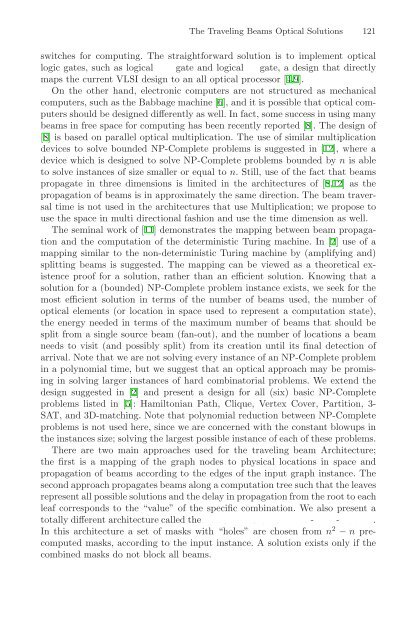Fun with Algorithms, 4 conf., FUN 2007(LNCS4475, Springer, 2007)(ISBN 9783540729136)(281s)_CsLn_
Fun with Algorithms, 4 conf., FUN 2007(LNCS4475, Springer, 2007)(ISBN 9783540729136)(281s)_CsLn_
Fun with Algorithms, 4 conf., FUN 2007(LNCS4475, Springer, 2007)(ISBN 9783540729136)(281s)_CsLn_
Create successful ePaper yourself
Turn your PDF publications into a flip-book with our unique Google optimized e-Paper software.
The Traveling Beams Optical Solutions 121switches for computing. The straightforward solution is to implement opticallogic gates, such as logical and gate and logical or gate, a design that directlymaps the current VLSI design to an all optical processor [4,9].On the other hand, electronic computers are not structured as mechanicalcomputers, such as the Babbage machine [6], and it is possible that optical computersshould be designed differently as well. In fact, some success in using manybeams in free space for computing has been recently reported [8]. The design of[8] is based on parallel optical multiplication. The use of similar multiplicationdevices to solve bounded NP-Complete problems is suggested in [12], where adevice which is designed to solve NP-Complete problems bounded by n is ableto solve instances of size smaller or equal to n. Still, use of the fact that beamspropagate in three dimensions is limited in the architectures of [8,12] as thepropagation of beams is in approximately the same direction. The beam traversaltime is not used in the architectures that use Multiplication; we propose touse the space in multi directional fashion and use the time dimension as well.The seminal work of [11] demonstrates the mapping between beam propagationand the computation of the deterministic Turing machine. In [2] use of amapping similar to the non-deterministic Turing machine by (amplifying and)splitting beams is suggested. The mapping can be viewed as a theoretical existenceproof for a solution, rather than an efficient solution. Knowing that asolution for a (bounded) NP-Complete problem instance exists, we seek for themost efficient solution in terms of the number of beams used, the number ofoptical elements (or location in space used to represent a computation state),the energy needed in terms of the maximum number of beams that should besplit from a single source beam (fan-out), and the number of locations a beamneeds to visit (and possibly split) from its creation until its final detection ofarrival. Note that we are not solving every instance of an NP-Complete problemin a polynomial time, but we suggest that an optical approach may be promisingin solving larger instances of hard combinatorial problems. We extend thedesign suggested in [2] and present a design for all (six) basic NP-Completeproblems listed in [5]: Hamiltonian Path, Clique, Vertex Cover, Partition, 3-SAT, and 3D-matching. Note that polynomial reduction between NP-Completeproblems is not used here, since we are concerned <strong>with</strong> the constant blowups inthe instances size; solving the largest possible instance of each of these problems.There are two main approaches used for the traveling beam Architecture;the first is a mapping of the graph nodes to physical locations in space andpropagation of beams according to the edges of the input graph instance. Thesecond approach propagates beams along a computation tree such that the leavesrepresent all possible solutions and the delay in propagation from the root to eachleaf corresponds to the “value” of the specific combination. We also present atotally different architecture called the coordinated holes in mask-made-blackbox.In this architecture a set of masks <strong>with</strong> “holes” are chosen from n 2 − n precomputedmasks, according to the input instance. A solution exists only if thecombined masks do not block all beams.


